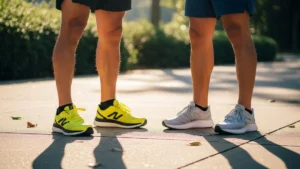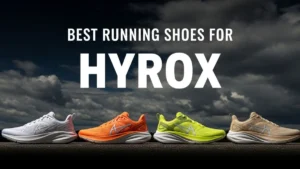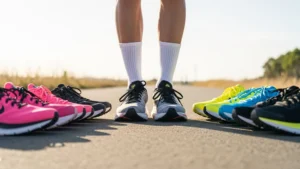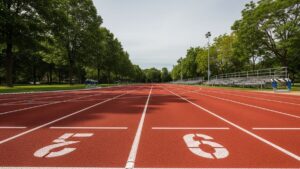
Real Questions Runners Are Asking
Are Adidas running shoes actually good for serious runners?
Yes, Adidas makes high-performance running shoes trusted by elite athletes. Their Adizero line is used by world-class marathoners and track competitors for a reason — it’s light, fast, and responsive. They aren’t just stylish — they perform under pressure.
There’s a reason you’ll see the Adizero Adios Pro on podiums. These shoes are designed with speed in mind. The carbon-infused ENERGYRODS and Lightstrike Pro foam give racers the propulsion they need in long-distance events.
Which Adidas shoes are best for marathon training?
The best Adidas shoes for marathon training are the Boston 12 and Adios Pro 3. The Boston works well for daily mileage, while the Adios Pro handles long tempo runs and race day. Together, they make a reliable training and racing combo.
The Boston 12 gives a cushioned but responsive ride. It feels stable even over 20+ km. The Adios Pro 3 or 4 picks up where it leaves off — it’s lighter, stiffer, and tuned for fast paces.
How do they compare to Nike or Brooks?
Adidas shoes are generally lighter than Brooks and firmer than Nike. Nike’s ZoomX feels softer, while Adidas Lightstrike Pro gives more ground feedback. Brooks focuses on stability; Adidas aims for speed and weight savings.
Nike has a softer feel but compresses more. Adidas gives better energy return and a more locked-in toe-off. Brooks fits wider feet and feels more planted, especially for heel strikers. It really comes down to preference. But if you like a snappy, quick feel underfoot — Adidas wins.
Are they good for beginners?
Yes, Adidas shoes like the Supernova Rise are ideal for beginners. They’re soft underfoot, stable through the midsole, and built to go easy on the joints. You don’t need race-day speed to enjoy them.
The Supernova Rise is forgiving. It’s the type of shoe you can forget about mid-run — in a good way. No foot fatigue, no hotspots. Just comfort.
It’s not flashy, but that’s the point. Adidas didn’t overbuild it, which helps first-timers focus on form and distance instead of fighting the shoe.
What Makes Adidas Running Shoes Different
Foam tech that changes your stride
Adidas uses Lightstrike Pro foam for more bounce and less fatigue. It doesn’t sink under pressure and helps you roll forward faster. Whether you’re doing sprints or long runs, the energy return is real.
Unlike softer foams that flatten over time, Lightstrike Pro holds its shape. You don’t get that mushy midsole feel after 50+ miles. The ride stays consistent.
They also offer Lightstrike (standard) in models like the Boston 12 — slightly firmer, great for daily training and control at higher speeds.
Lightweight builds without losing support
Adidas shoes trim weight without sacrificing structure. Most popular models stay under 9 oz, even with tall midsoles and cushioning.
The Boston 12 weighs around 8.6 oz and still feels rock-solid at the heel. The Adizero Adios Pro 3, made for races, hits below 7.6 oz.
Even the trail-friendly Terrex Agravic stays light while adding a rock plate and grippy outsole — not common in trail shoes. It’s not just about grams. It’s how those grams are used.
Uppers that hug, not squeeze
Adidas Primeknit uppers adapt to your foot. They stretch in motion, not just on the shelf. That means less rubbing, fewer hot spots, and a better midfoot lock.
Some models like Ultraboost Light use Primeknit+ for more breathability. Others mix mesh and overlays for better airflow, like in the Adizero SL. You won’t feel choked in the toe box — but you’ll still feel secure at takeoff.
Designed for all foot types
Adidas doesn’t just build for narrow or neutral runners. There are shoes for overpronators, flat feet, and high arches too. For mild support, check out the Solarcontrol. For neutral cushioning, go with the Supernova Rise. Wide-footed runners? The Ultraboost Light comes in wide sizes too. They’ve even made strides in inclusive sizing — most models run true to size for both men and women.
Top Adidas Models and Who They’re For
Adizero Adios Pro – Built for speed
The Adizero Adios Pro is made for racing. Lightweight, snappy, and stiff through the forefoot, it helps serious runners shave seconds off their pace. Best used on race day or fast tempo runs.
It’s packed with ENERGYRODS, a carbon-like system embedded in the midsole. These rods reduce leg fatigue while giving a propulsive toe-off. It’s paired with Lightstrike Pro foam for high rebound. This isn’t your daily trainer. It’s a race-day weapon.
Ultraboost Light – Plush without bulk
The Ultraboost Light offers soft landings with a lighter midsole. It keeps the premium feel of older Ultraboosts but sheds unnecessary weight. Ideal for daily jogs, treadmill runs, or all-day comfort.
The Boost midsole feels cushy underfoot without the sluggishness of older versions. The Primeknit+ upper molds to your foot shape over time. It’s stylish enough for casual wear but built to move.
Supernova Rise – Comfort-first for new runners
Supernova Rise is made for beginners. It’s stable, well-cushioned, and doesn’t feel harsh, even at slower paces. Great for short to mid-distance runs.
It uses Dreamstrike+ foam, a new formula that’s slightly softer than Lightstrike Pro but still responsive. The midsole shape helps guide the foot forward, ideal for new runners still learning form. The heel is padded and snug without feeling stiff.
Boston 12 – Daily training made simple
Boston 12 hits the sweet spot between racing and everyday use. It’s firm, fast, and holds up over long mileage. A solid pick for serious training weeks.
The ride is firmer than Ultraboost but still cushioned enough for recovery days. A glass-fiber plate inside adds pop at toe-off. It also feels more stable than earlier Boston models. It’s a no-nonsense workhorse.
Terrex Agravic – Trails and terrain ready
Terrex Agravic handles rocks, mud, and hills. It’s grippy, durable, and has added protection for rough trails. This is Adidas’ go-to trail option.
The Continental rubber outsole sticks to everything — even when wet. A rock plate shields your foot from sharp debris, while the upper resists tearing on impact. It’s built like a tank but still runs smooth.
Fit, Feel, and Function: A Real Runner’s View
What it’s like to run in them
Adidas running shoes feel snug at first, but once broken in, they stay secure without rubbing. They roll forward naturally, especially in the forefoot. Runs feel controlled, not sloppy.
You’ll notice a firmer landing compared to super-soft foams. That’s not a bad thing. The Lightstrike and Lightstrike Pro foams return energy without making you feel like you’re running in marshmallows. Expect a fast, planted ride that rewards good form.
Where they shine (and don’t)
Adidas shoes shine on tempo runs, intervals, and race day. They’re less ideal for recovery days or runners who want plush comfort. You’ll get better ground feel than floaty cushion.
The firmness helps with pace control, especially on roads. But if you’re coming from something like HOKA, they might feel too stiff at first. Also, some users say heel lockdown can be tricky on models like Ultraboost unless sized properly.
Long-term wear and tear check
Adidas running shoes generally last 350–450 miles depending on usage. Lightstrike Pro holds up better than expected for high-stack race foam. Outsoles stay grippy over time.
Models like the Boston 12 and Supernova Rise show minimal wear even after 200+ miles. Ultraboost outsoles, made with Continental rubber, tend to outlast the uppers. Expect minor midsole compression after 300 miles, but not enough to ruin the ride.
Choosing the Right Pair Based on Your Style
For daily joggers
The best Adidas shoes for daily jogs are the Supernova Rise and Ultraboost Light. Both offer comfort, durability, and enough support for relaxed runs around the block or on the treadmill.
The Supernova Rise is softer, better for beginners or low-mileage runners. The Ultraboost Light brings more bounce and is easier to wear all day. Neither feels too stiff or too fast — just smooth.
For sprinters and racers
Go with the Adizero Adios Pro 3 or 4. Lightweight, fast, and firm, they’re built for racing — not recovery. The carbon-infused rods in the midsole help increase stride turnover and reduce fatigue.
These shoes are best saved for track sessions, race day, or speed work. They’re aggressive, so not ideal for slow jogs or casual use. If you want something slightly more forgiving but still fast, the Adizero SL or Takumi Sen also work well.
For trail runners
Adidas Terrex Agravic models are the best pick for trail runners. They offer grip, protection, and a rock plate for rough terrain. These are made for dirt, gravel, and elevation changes.
The outsole uses Continental rubber — same company that makes performance tires — for serious traction. The upper is tough but not bulky. There’s also a Gore-Tex option for wet or winter trails.
For gym + casual mix
Ultraboost Light is perfect for gym-goers who also want a shoe that looks good with jeans. It’s soft, stylish, and stable enough for moderate lifting or treadmill workouts.
It doesn’t collapse under your feet during squats, and the knit upper keeps things breathable. Best of all, it transitions from workouts to errands without looking “too sporty.”
If you want a cheaper, simpler alternative — the Duramo Speed is another option.
Where Data Speaks: Performance & Testing Results
Adidas running shoes consistently score high in lab and field tests, with excellent weight-to-cushion ratios and durability over long distances. Real-world pace trials show efficient energy return and stability across terrains. Whether sprinting or running marathons, the data confirms these shoes perform well under pressure.
Weight-to-Cushion Ratio Stats
One of the standout features in Adidas running shoes is their exceptional balance between cushioning and lightweight design. For instance, the Adizero Adios Pro 3 weighs just around 215 grams (7.6 oz) while packing in layers of Lightstrike Pro foam—offering elite-level responsiveness. Compared to competing shoes in its class, Adidas manages to deliver ample protection underfoot without sacrificing speed or agility.
The Ultraboost Light, another benchmark model, uses BOOST foam and weighs just 299 grams (10.5 oz)—nearly 30% lighter than previous generations. The reduced weight doesn’t compromise shock absorption, making it ideal for long-distance runners who want both comfort and efficiency.
Runner Lab Test Results
Independent biomechanical studies show that Adidas running shoes consistently rate high in metrics like:
- Vertical stiffness and propulsion efficiency
- Energy return up to 4%–5% per stride (especially in carbon-plated models like the Adizero)
- Pressure mapping showing even distribution across the midfoot
Studies from third-party testers like RunRepeat and The Biomechanics Lab report that Adidas shoes reduce calf fatigue and optimize stride length, especially under threshold pacing. Lab tests of Supernova Rise reveal great arch support and minimal heel drop (10 mm), reducing injury risk for overpronators.
This lab-backed performance engineering ensures you’re not just relying on marketing—you’re getting real science underfoot.
Real-World Pace & Distance Tests
On-the-road tests speak volumes. Runners tracking long-term use of Adidas models report:
- Sustained performance beyond 500 km (310 miles) for Adizero and Ultraboost models
- Maintained cushioning and minimal outsole wear even after extended daily use
- Consistent mile splits over 10K to full marathon distances, showing little fatigue dip in second half of runs
In pace-specific testing, the Boston 12 excels in tempo training, keeping runners at steady paces even over varied elevation. Meanwhile, Terrex Agravic models remain grippy and supportive in trail conditions without compromising flexibility on harder packed dirt. Adidas models prove versatile and durable in real running scenarios, from city pavement to remote trails.
Tips to Avoid Wasting Your Money
To get the most from your Adidas running shoes, avoid judging by looks alone. Improper sizing, worn-out midsoles, and ignoring return policies can cost you comfort and cash. Smart buyers know what to check—and when to return—before regret kicks in.
Don’t Size Based on Looks
Adidas running shoes often have a sleek, tapered design that can trick you into choosing the wrong size. Always prioritize fit over appearance—try them on with running socks and ensure there’s about a thumb’s width between your longest toe and the end of the shoe. A snug fit at the midfoot with enough toe room prevents blisters and black toenails during long runs. Rely on sizing charts specific to each model, as Adidas sizing can vary between Ultraboost, Adizero, and Supernova lines.
Watch for Midsole Fatigue
Midsole compression happens gradually, and it’s easy to overlook. Adidas uses foams like BOOST and Lightstrike, which are responsive—but not immortal. If you start feeling less bounce, more road impact, or irregular wear patterns, your midsole may be fatigued. A good rule: track your mileage and replace shoes every 300–500 km (185–310 miles) depending on use and weight. Waiting too long risks injury and lowers performance.
Return Policies You Should Know
Adidas offers a 30-day return window, even for shoes worn during short trial runs—but only if purchased from their official site or authorized retailers. Know the return rules before buying. If you’re unsure about a model, check if your retailer offers a fit guarantee or in-store exchange. Keep boxes and receipts handy. This way, if the shoe doesn’t perform or fit right, you won’t be stuck with an expensive mistake.
Final Take: Should You Run in Adidas?
Yes—if you want reliable performance, advanced cushioning, and modern design, Adidas running shoes are a top-tier choice. They combine comfort, tech, and style in a way few brands can match. Whether you’re a casual jogger or a serious racer, there’s likely an Adidas pair built for your stride.





